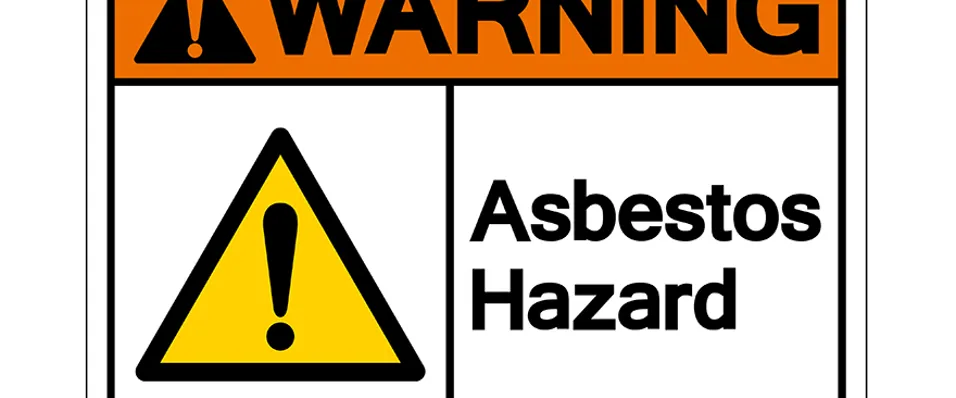
Asbestos guidance for electricians
Its use was progressively reduced between the 1970s and 1999 when all remaining forms were finally prohibited in the UK with the implementation of the Asbestos (Prohibitions) (Amendment) Regulations 1999. Asbestos has also been removed from various properties over the years for various reasons, for example, because of damaged material, or for refurbishment and demolition, but a substantial proportion of the original products still remain. These materials, if undetected, can present an ongoing risk to workers carrying out building repair and maintenance or improvement and refurbishment work. Workers at potential risk include electricians and other building trades.
This document has been prepared to provide guidance on asbestos for electricians.
The document has the following objectives:
- To describe asbestos and asbestos-containing materials (ACMs).
- To explain the health effects and risks from exposure to asbestos and the legal requirements.
- To explain the risks for electricians.
- To provide information on where ACMs are likely to be found in electrical and related work.
- To highlight the actions to take to reduce the potential for inadvertently disturbing ACMs in buildings.
- To describe the asbestos-related work (with appropriate controls) that electricians can carry out where adequate training has been provided
- To provide information for dealing with emergencies.
Asbestos and ACMs
‘Asbestos’ is the collective commercial name for a range of naturally occurring fibrous silicate minerals, which include crocidolite, amosite and chrysotile. These minerals are commonly known as ‘blue’, ‘brown’ and ‘white’ asbestos, respectively. Historically, asbestos minerals were mined, processed and refined through a series of crushing and size separation stages and manufactured into an extensive and eclectic range of products, items and materials. Tens of millions of tonnes of ACMs were manufactured in the UK, particularly for use in the construction industry. Many of these products were installed in new or refurbished premises, such as domestic houses and flats, hospitals, schools, department stores, university buildings and municipal and community buildings during the post-war construction period between 1950 and 1980. Asbestos has excellent fire, chemical, water and heat-resistance properties, which explains its widespread use.
The more common construction applications of ACMs include:
- insulation/lagging on pipes, tanks and boilers
- sprayed coatings used for fire protection on roofs, ceilings and structural supports such as columns and beams
- asbestos insulating board (AIB) materials/firebreaks as panels and boards (including door panels, ceiling tiles and partitions and walls)
- asbestos cement (AC) items, including roof and wall profiled sheeting, drainage pipes and gutters (chrysotile used in AC products was the most commonly commercially used asbestos type).
Health effects and risks from asbestos
Asbestos is an extremely hazardous and dangerous material. All the main asbestos types are classed as Group 1 human carcinogens by the International Agency for Research on Cancer (IARC). Inhalation of asbestos fibres can cause a number of fatal or serious respiratory conditions, including lung cancer, pleural and peritoneal mesothelioma (cancers of the chest lining/chest cavity and abdominal cavity lining, respectively) and asbestosis (fibrosis of the lung). Smoking greatly increases the risk of developing asbestos-related lung cancer.
Freely occurring asbestos fibres are microscopic (i.e. around some two thousand times smaller than a human hair) and can only be identified under a microscope. Asbestos fibres are produced and released into the air when asbestos products are damaged or disturbed, particularly by physical action such as being broken, smashed, cut, drilled, sanded, scraped, sawed or otherwise insulted, and also when asbestos debris and dust is disturbed or dislodged, for example, when sweeping up. It is, however, important to note that asbestos products do not pose a risk to health simply by being present in buildings or any environment.
The latest data from the Health and Safety Executive (HSE) shows that currently, over 5,500 people die each year from asbestos-related diseases (2017 data). This includes some 500 and 2,500 deaths from asbestosis and mesothelioma, respectively (see Figure 1). These are primarily work-related deaths. Around 40-50% of these deaths are from building trades-related occupations (including electricians, joiners and plumbers) and maintenance workers. The deaths are the result of previous exposures, as the latency period for the disease to develop is usually 20-40 years after initial exposure. Asbestos-related deaths are far greater than the total number of people killed in road traffic collisions in 2018, which stood at 1,784.
People often fail to recognise the dangers of asbestos, or are complacent regarding the risks to health, because there is no immediate or acute effect. Other dangers we encounter every day, such as electrical or gas risks, or even the danger of driving on the road, seem more dangerous and are taken more seriously, as the consequences of these are instant.

However, it is important to recognise that there is no ‘safe’ level of exposure to asbestos. Every exposure and every incident gives rise to a risk of developing mesothelioma in its own right. Each exposure also builds on previous exposures, so that the risk of disease increases with every incident. Consequently, the risk of developing future disease can only be reduced by avoiding and minimizing asbestos disturbance and exposure incidents.
Legal requirements for asbestos
There are specific legal requirements that apply to all ‘work’ (and potential work) with asbestos and to premises that contain asbestos. The main piece of legislation is the Control of Asbestos Regulations (CAR) 2012.
The Regulations place duties on two main groups:
- employers (for example, electrical contractors) whose employees may carry out any work that is liable to disturb ACMs, and
- ‘property’ dutyholders (i.e. the owners and occupiers of non-domestic premises) who have maintenance and repair responsibilities for the property.
Employers’ duties
Employers must identify the presence of asbestos before any electrical or other work is carried out that is liable to disturb asbestos (CAR 2012, Regulation 5). This ‘work’ includes access or preparatory work, etc. around electrical equipment. The purpose of the identification of asbestos will in many cases be to avoid disturbing the material.
If work on the ACM is actually planned by the employer, there are further requirements on the company to carry out a risk assessment and to prepare a plan of work that identifies the appropriate controls for minimizing exposure and preventing the spread of fibres. There are also additional requirements for training of workers and for the cleaning of workers and work areas.
Electrical contractors can carry out low-hazard work on ACMs so long as they are trained and competent. High-hazard work can only be performed by specialist (licensed) contractors.
Duties of property holders
The presence of asbestos in buildings is usually established in a survey of the premises (see section on Asbestos surveys below). This is required by property dutyholders in non-domestic premises. Property holders should pass this survey information onto electrical and other contractors carrying out repair or maintenance and other work. If there is no information available from the property holder, the electrical contractor has a responsibility to identify the asbestos themselves.
Why is asbestos a hazard to electricians?
Asbestos was used extensively as a building product. It was also used in certain electrical equipment, due to its heat resistance and fire protection properties. During the course of their work, electricians, like all tradespeople, are very likely to encounter asbestos at various points in their careers. Asbestos may be found in electrical equipment and also in the surrounding building materials. It is therefore important to be able to identify the locations where it may be encountered, to prevent accidental exposure.
Where might I find asbestos?
Electrical equipment that contains ACMs

Some of the most likely ACMs to be encountered by electricians are asbestos flash guards within rewireable fuse carriers. These are a loosely bound material and extremely friable, which means that they release fibres easily.
Flash guards are most likely to be found within fuse carriers in distribution boards and would require an operative carrying out maintenance, such as replacing a fuse, to remove the fuse from the carrier, which would expose the flash guards, potentially releasing fibres into the atmosphere that could be breathed in.
If such items are discovered during the course of compiling an Electrical Installation Condition Report (EICR), the client should be advised of the hazard and the risk to persons likely to be in the vicinity or carrying out maintenance on the equipment should be assessed. The safest course of action would be to remove and dispose of the equipment in accordance with HSE requirements. Removal of such items must only be carried out by competent persons and special precautions must be taken when handling or during removal or disposal of such items, in accordance with the guidance available on the HSE website.
Arc chutes are used in circuit-breakers to insulate and protect circuits from shorting by preventing a high voltage spark from jumping from one contact to another. The arc chute acts as a barrier between two contacts.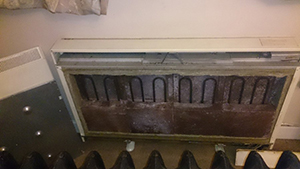
Prior to the mid-1980s, arc chutes were made from asbestos-containing plastic moulding compound. It is possible that a high voltage spark could crack the arch chute, creating dust and particles.
Storage heaters can be a problem, as they may contain asbestos and, once the cover has been removed, fibres may be released. Information can be found on the Asbestos Information Centre (AIC) website, which details the storage heater makes and models that contain asbestos. This information can be reviewed before work commences, reducing the risk of possible exposure.
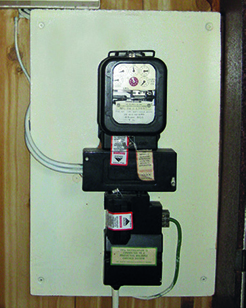
Other ACMs that may be encountered whilst accessing work areas
Asbestos insulating board (AIB) is particularly dangerous if drilled, cut, broken or disturbed in any way, as it can release thousands of fibres into the air, which will contaminate the surrounding areas and could be breathed in.
This material came in large sheets and had many uses, including lining the inside of boiler rooms or warm air unit cupboards.
AIB was also used extensively as fire protection on or in the vicinity of electricity and gas meters.
Guidance was published on this in 2014 by the Association of Meter Operators.
Pipe lagging and insulation is a material that is particularly dangerous.
It is fibrous and easily disturbed when carrying out electrical works in close proximity.
Work on these products is to be carried out by a licensed contractor only.
Older textured coatings (i.e. pre-1990), more commonly known as Artex, represent another possible risk of exposure to asbestos.
Asbestos in Artex ceased to be used around 1985-90 and was banned in 1992. Precautions should be taken if drilling is required in textured coatings.
The HSE document a26 provides guidance on drilling and boring through textured coatings and is available on the HSE website.
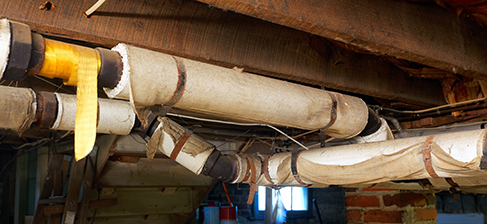
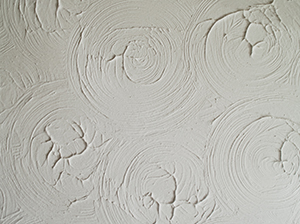
Asbestos surveys
Due to the extensive use of asbestos in buildings and electrical equipment, ACMs are likely to be encountered by electricians. Work will, therefore, need to be properly planned and the potential for asbestos properly considered. The main source of information will be the asbestos survey.
CAR 2012 requires building dutyholders, such as building owners and other persons with responsibility for maintenance, to manage asbestos in their premises. ACMs should normally be identified by having a survey carried out, which will provide a report, detailing information to enable asbestos to be managed safely. It will provide accurate information on the type, quantity and condition of any ACMs present. The asbestos register should be made available to anyone carrying out works in the building. It is important to understand any restrictions to the report, which should be clearly documented.
There are two types of asbestos survey: a management survey and a refurbishment and demolition survey.
A management survey is likely to involve minor intrusive works. It will usually involve sampling and analysis to determine if suspected materials contain asbestos. It can also involve the presumption of the presence or absence of asbestos.
A refurbishment and demolition survey is required before any refurbishment or demolition works are carried out. This is a fully intrusive survey. The asbestos surveyor will require extensive knowledge of the scope of works to be carried out, in order to ensure the relevant areas are thoroughly inspected and samples taken and analysed.
This can sometimes be something of a chicken and egg situation: an asbestos inspector will not be competent to carry out the necessary procedures to isolate the supply for electrical equipment to safely carry out the inspection, so is likely to presume the presence or absence of ACMs. This can be unhelpful, as if the material is presumed to be an ACM, the electrical contractor will have to take additional precautions, which will increase the cost to the client. Equally, if the material is presumed not to be an ACM, the electrical contractor could be at risk if it turns out to be an ACM. It may be prudent to consult a licensed asbestos contractor and electrical contractor to attend site at the same time.
Electricians must always check the survey document before starting work. There is a danger that the survey document will not be up to date or complete or will not cover the area to be worked on. If there is any doubt about the quality or completeness of the survey report, work should not start. Employers have legal duties to comply with the requirements of CAR 2012 to ensure that workers are not exposed to asbestos. The HSE website provides more guidance on asbestos surveys.
Domestic properties
The requirement to manage asbestos in buildings only applies to non-domestic properties such as commercial, industrial and public buildings. It does not apply to domestic properties. Therefore, in domestic properties, self-employed electricians and employers of electricians have a duty under Regulation 5 of CAR 2012 to identify any asbestos before work starts, to prevent disturbance and risk to health.
Can I work with asbestos?
There are certain items of work, classed as non-licensed work, that can be carried out by electricians if they are competent to do so. This work must be carried out carefully and in strict accordance with HSE guidance. It can be very expensive and time-consuming to purchase the necessary equipment and to gain sufficient information, instruction and training to work with asbestos as an electrical contractor, and most, therefore, employ the services of a licenced asbestos contractor, as this is far more cost-effective. The HSE website provides guidance on managing and working with asbestos.
What should I do if I discover or disturb asbestos?
If you think you have discovered asbestos, it is important to stop work immediately and make sure nobody can access the area. You must then report it to your supervisor or manager, as it will need to be investigated.
If asbestos has actually been disturbed, a precautionary approach should be applied. Clothing may have become contaminated, in which case you must follow the emergency procedures as detailed on the HSE website.
You must report the incident to your manager and person in charge of the building and provide a warning sign to warn others of the ‘possible asbestos contamination’. A licensed specialist asbestos contractor will be needed to decontaminate the area if required and to take a sample to be analysed and confirm the presence of asbestos.
If following analysis, it is confirmed that asbestos exposure has occurred, the incident may have to be reported to the HSE under the Reporting of Injuries, Diseases and Dangerous Occurrences (RIDDOR) Regulations 2013, as a dangerous occurrence. Details on the circumstances in which incidents should be reported are set out on the HSE Asbestos FAQ page.
In the event that asbestos is discovered or disturbed, the HSE website provides guidance on what to do. This should be strictly followed.
Figure 2: HSE Guidance

How can I stay safe from asbestos?
Education is the best way to stay safe from asbestos. You should arm yourself with sufficient information, instruction and training.
Do I need asbestos training?
Employers must ensure that anyone who is likely to disturb asbestos during the course of their work (including self-employed workers) has the correct training to enable them to work safely and competently without risk to anyone. There are many training providers and at least two training associations, including the Independent Asbestos Training Providers (IATP) and the United Kingdom Asbestos Training Association (UKATA). These organizations will be able to provide information on asbestos awareness training and working with asbestos.
There are courses available on asbestos awareness and on licensed and non-licensed work with asbestos. However, it is important to understand that simply attending a training course will not make an operative competent. Competence is a combination of training, learning on the job, instruction and assessment. The HSE website provides information on competency.
Myths
Some electricians feel that they are adequately protected from breathing in asbestos fibres by using a dust mask.
Many types of disposable masks are not suitable for use against asbestos fibres (for example, very simple and looser-fitting masks, such as those used in medical situations). A type FFP3 disposable dust mask to EN 149 should be used. Half-masks with a P3 filter would also be suitable. Anyone using respiratory protective equipment (RPE) must be properly trained and competent in the fitting and wearing of it. In addition, as we don’t all have the same shape or size of face, a face-fit test is required to ensure that the mask selected correctly fits the wearer.
It is also important to understand how to use the equipment. A mask may provide little or no protection if the person has stubble or a beard, as the fibres will be breathed in through the sides of the mask where it does not fit tightly to the face.
There are many other things to consider, such as protecting the work area, clothing and shoes from contamination. Personal protective equipment (PPE) should be worn when asbestos work is carried out.
Further information on PPE and RPE can be found on the HSE website.
Summary
As an electrician, you are likely to encounter asbestos during your career. It’s important to know how to identify it and how to deal with it, should it be disturbed. Asbestos awareness courses provide valuable information, which you will retain and hopefully pass on to others, helping to keep us all safe from asbestos.
Don’t be afraid to challenge an asbestos report. You should understand the limitations of the report and if you feel it does not provide sufficient information to allow you to carry out the work safely, you must not start work.
With regard to working with asbestos, electricians can only work with lower hazard (i.e. non-licensed) asbestos materials, provided they are properly trained and apply adequate controls. Therefore, in many situations, a specialist licensed asbestos contractor will be better suited to carry out work on asbestos. However, if you do work with or near asbestos, you must ensure the HSE guidance is strictly followed and the correct PPE and RPE is used.
Further sources of information
HSE: Control of Asbestos Regulations 2012
HSE: Asbestos: The survey guide
HSE: Managing and working with asbestos
HSE: Asbestos information, instruction and training
HSE guide a26 asbestos essentials: Drilling and boring through textured coatings
Asbestos Information Centre: Storage Heaters Containing Asbestos
We would like to thank the following for providing images for this publication:
- The Health and Safety Executive (This article contains public sector information published by the Health and Safety Executive and licensed under the Open Government Licence)
- Armco Asbestos Surveys
- KNE Ltd
